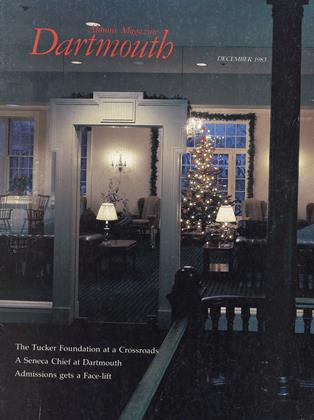Last summer, George Hathorn was quietly transferred out of Buildings and Grounds and named Assistant Director of Facilities Planning and Resident Architect. The latter position, which Hathorn has held since 1977, has been unheard of since the days of Jens Frederick Larsen. Although the College is not planning a building spree similar to the one of Larsen's time, having an in house practitioner is providing the College with a knowledgeable aesthetic adviser and allowing for quality renovations such as the recently completed work on McNutt Hall.
A graduate of Yale School of Architecture, Hathorn was initially hired on as a draftsman. "I was overqualified, but I was married, had kids, and I needed to eat." Hathorn continued by explaining his dilemma after graduating from Yale at a time when it was in the forefront of challenging Modernism. It was, he said, "analogous to getting out of rock and roll school and having a choice of working for either Lester Lanin or Tommy Dorsey." For him, the draftsman job was perfect it was unpretentious and he was able to learn about costs, to supervise construction, and to work with the workmen who were making his designs a reality.
After a decade of association with the College, Hathorn has been able to see how his and other designs stand the test of time in regards to function, maintenance, and aesthetics. With this perspective and the skills acquired at Buildings and Grounds, Hathorn is able to design with a greater awareness of the on-going problems that are likely to be encountered. He has also acquired a "natural knowledge of what is appropriate for the College." Not only has he stood in front of Dartmouth Row and walked across the campus, he has also been in every attic and basement on campus. As a result, Hathorn has become more appreciative of the College's neo-Georgian character.
This awareness of the College appearance will undoubtedly be reflected in the buildings of the future. Although Hathorn is not responsible for the design of large-scale additions to the campus, he will be involved in the selection of outside architects and will be providing input through his position as chairman of the Design Review Committee. Established by President McLaughlin in April of 1982, this committee is charged with reviewing what new buildings will look like and how they will be integrated into the campus. In addition, the Committee may suggest initiatives for existing buildings.
Hathorn is a connoisseur of the finely-designed traditional motif as evidenced by his own dress camel's hair coat, well-tailored shirts, and wool flannel slacks; his furnishing selections Windsor chairs, leather sofas, brass chandelier and sconces for the admissions office; and his disdain for remodelings insensitive to the neo-Georgian character. Yet he is not averse to tearing down buildings that are unable to provide adaptive re-use. Hathorn cites Webster Hall as a structure in this category. Reflecting his Vermont heritage, Hathorn would prefer to see Webster "die with dignity" than be hacked away with a tuck here and a wrinkle there. His own fantasy for the Baker Library area would be to complete the east side of the library with a replica of Sanborn, thereby finishing Larsen's composition and providing a more defined Baker "Yard." After viewing Hathorn's successes around campus the Faculty Club, renovations at Tuck School and the President's House, and most recently, the revitalized admissions office one wonders if perhaps Hathorn ought to be allowed or better yet encouraged, to see his fantasy occur?
In my Mind's Eye
 View Full Issue
View Full Issue
More From This Issue
-
 Feature
FeaturePsycho-Social Dynamics and the Prospects for Mankind
December 1983 By Charles E. Osgood '39 -
 Feature
FeatureMaris Bryant Pierce: A Seneca Chief at Dartmouth
December 1983 By Howard A. Vernon -
 Cover Story
Cover StoryCROSSROADS
December 1983 By Shelby Grantham -
 Feature
FeatureOn a Scale of 1 to 10...
December 1983 By Brad Hills '65 -
 Feature
FeatureAdmissions gets a Face-lift
December 1983 By Nancy Wasserman -
 Sports
SportsSports
December 1983 By Kathy Slattery







